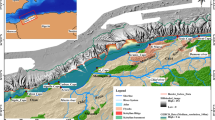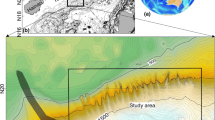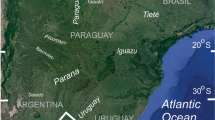Abstract
A geomorphological and statistical analysis of slope canyons from the northern KwaZulu-Natal continental margin is documented and compared with submarine canyons from the Atlantic margin of the USA. The northern KwaZulu-Natal margin is characterized by increasing upslope relief, concave slope-gradient profiles and features related to upslope growth of the canyon forms. Discounting slope-gradient profile, this morphology is strikingly similar to canyon systems of the New Jersey slope. Several phases of canyon incision indicate that downslope erosion is also an important factor in the evolution of the northern KwaZulu-Natal canyon systems. Despite the strong similarities between the northern KwaZulu-Natal and New Jersey slope-canyon systems, key differences are evident: (1) the concavity of the northern KwaZulu-Natal slope, contrasting with the ∼linear New Jersey slope; (2) the relative isolation of the northern KwaZulu-Natal canyons, rather than the dense clustering of the New Jersey canyons; and (3) the absence of strongly shelf-breaching canyons along the northern KwaZulu-Natal margin. In comparison with the New Jersey margin, we surmise a more youthful stage of canyon evolution, a result of either the canyons themselves being younger or the formative processes being less active. Less complicated patterns of erosion resulting from reduced sediment availability have developed in northern KwaZulu-Natal. The reduction in slope concavity on the New Jersey margin may be the result of grading of the upper slope by intensive headward erosion, a process more subdued—or less evident—on the KwaZulu-Natal margin.











Similar content being viewed by others
References
Adams EW, Schlager W (2000) Basic types of submarine slope curvature. J Sediment Res 70:814–828
Carlson PR, Karl HA (1988) Development of large submarine canyons in the Bering Sea, indicated by morphologic, seismic and sedimentologic characteristics. Geol Soc Amer Bull 100:1594–1615
Chamberlain TK (1964) Mass transport of sediment in the heads of Scripps Submarine Canyon, California. In: Miller R (ed) Papers in marine geology, Shepard commemorative volume. MacMillan, New York, pp 42–64
Cooper JAG (1994) Lagoons and microtidal coasts. In: Carter RWG, Woodruffe CD (eds) Coastal evolution: late Quaternary shoreline morphodynamics. Cambridge University Press, Cambridge, pp 219–265
Daly RA (1936) The origin of submarine canyons. Am J Sci 5 31:401–420
Dingle RV, Robson S (1985) Slumps, canyons and related features on the continental margin off East London, SE Africa (southwest Indian Ocean). Mar Geol 67:37–54
Dingle RV, Goodlad SW, Martin AK (1978) Bathymetry and stratigraphy of the northern Natal Valley (SW Indian Ocean). A preliminary report. Mar Geol 28:89–106
Dingle RV, Siesser WG, Newton AR (1983) Mesozoic and Tertiary geology of southern Africa. Balkema, Rotterdam
Drake DE, Hatcher PG, Keller Gm (1978) Suspended particulate matter and mud deposition in upper Hudson Submarine Canyon. In: Stanley DJ, Kelling GE (eds) Sedimentation in submarine canyons, fans and trenches. Dowden Hutchinson Ross, Stroudsburg, PA, pp 33–41
Du Toit SR, Leith MJ (1974) The J(c)-1 bore-hole on the continental shelf near Stanger, Natal. Trans Geol Soc S Afr 77:247–252
Farre JA, McGregor BA, Ryan WBF, Robb JM (1983) Breaching the shelfbreak; Passage from youthful to mature phase in submarine canyon evolution. In: Stanley DJ, Moore GT (eds) The shelfbreak: critical interface on continental margins. Soc Econ Palaeontol Mineral Spec Publ 33:25–39
Fricke H, Hissmann K (1994) Home range and migrations of the living coelacanth Latimeria chalumnae. Mar Biol 120:171–180
Fricke H, Plante R (1988) Habitat requirements of the living coelacanth Latimeria chalumnae at Grande Comore, Indian Ocean. Naturwissenschaften 15:149–151
Goff JA (2001) Quantitative classification of canyon systems on continental slopes and a possible relationship to slope curvature. Geophys Res Lett 28:4359–4362
Goodlad SW (1986) Tectonic and sedimentary history of the mid-Natal Valley (SW Indian Ocean). Joint Geological Survey/University of Cape Town, Marine Geoscience Unit Bull 15
Green AN, Uken R (2005) First observations of sea level indicators related to glacial maxima at Sodwana Bay, Northern KwaZulu-Natal. S African J Sci 101:236–238
Green AN, Perritt SH, Leuci R, Uken R, Ramsay PJ (2007) Potential sites for coelacanth habitat using bathymetric data from the western Indian Ocean. S African J Sci (in press)
Meyer R, Talma AS, Duvenhage AWA, Eglington BM, Taljaard J, Botha JF, Verwey J, Van der Voort I (2001) Geohydrological investigation and evaluation of the Zululand coastal aquifer. Pretoria, Water Research Commission Rep 221/1/01
Miller WR (2001) The bathymetry, sedimentology and seismic stratigraphy of Lake Sibaya—Northern KwaZulu-Natal. Council Geosci Bull 131
Mitchell MC (2005) Interpreting long-profiles of canyons in the USA Atlantic continental slope. Mar Geol 214:75–99
O’Grady DB, Syvitski JPM, Pratson LF, Sarg JF (2000) Categorizing the morphologic variability of siliciclastic passive continental margins. Geology 28:207–210
Orange DL, Breen NA (1992) The effects of fluid escape on accretionary wedges. 2. Seepage force, slope failure, headless submarine canyons and vents. J Geophys Res 97:9277–9295
Orange DL, Anderson RS, Breen NA (1994) Regular canyon spacing in the submarine environment: the link between hydrology and geomorphology. GSA Today 4:29–39
Partridge TC, Maud RR (1987) Geomorphic evolution of southern Africa since the Mesozoic. S African J Geol 90:179–208
Pratson LF, Coakley BJ (1996) A model for the headward erosion of submarine canyons induced by downslope eroding sediment flows. Geol Soc Am Bull 108:225–234
Pratson LF, Ryan WBF, Mountain GS, Twitchell DC (1994) Submarine canyon initiation by downslope-eroding sediment flows: evidence in late Cenozoic strata on the New Jersey continental slope. Geol Soc Am Bull 106:395–412
Ramsay PJ (1994) Marine geology of the Sodwana Bay shelf, Southeast Africa. Mar Geol 120:225–247
Ramsay PJ (1996) Quaternary marine geology of the Sodwana Bay shelf, northern KwaZulu-Natal. Bull Geol Surv S Afr 117
Ramsay PJ, Miller WR (2006) Marine geophysical technology used to define coelacanth habitats on the KwaZulu-Natal shelf, South Africa. S African J Sci 102:427–434
Robb JM (1984) Spring sap** on the lower continental slope, offshore New Jersey. Geology 12:278–282
Shaw MJ (1998) Seismic stratigraphy of the northern KwaZulu-Natal upper continental margin. M Sc Thesis, University of Natal, Durban
Shepard FP, Curray JR, Innan DL, Murray EA, Winterer EL, Dill RF (1964) Submarine geology by diving saucer: bottom currents and precipitous submarine canyon walls continue to a depth of at least 300 meters. Science 145:1042
Sydow CJ (1988) Stratigraphic control of slum** and canyon development on the continental margin, east coast, South Africa. BSc Honours Thesis, University of Cape Town, Cape Town
Twichell DC, Roberts DG (1982) Morphology, distribution and development of submarine canyons on the United States Atlantic continental slope between Hudson and Baltimore Canyons. Geology 10:408–412
Acknowledgements
This study comprises part of A. Green’s PhD thesis at the University of KwaZulu-Natal. This work was made possible by funding received from the African Coelacanth Ecosystem Programme via the National Research Foundation, the Department of Science and Technology, and the Department of Environmental Affairs and Tourism. Multibeam data were collected by Marine GeoSolutions (Pty) Ltd, who we gratefully acknowledge. P.J. Ramsay, an anonymous reviewer and the editor, B.W. Flemming are thanked for their various comments regarding this manuscript. UTIG contribution #1870.
Author information
Authors and Affiliations
Corresponding author
Rights and permissions
About this article
Cite this article
Green, A.N., Goff, J.A. & Uken, R. Geomorphological evidence for upslope canyon-forming processes on the northern KwaZulu-Natal shelf, SW Indian Ocean, South Africa. Geo-Mar Lett 27, 399–409 (2007). https://doi.org/10.1007/s00367-007-0082-2
Received:
Accepted:
Published:
Issue Date:
DOI: https://doi.org/10.1007/s00367-007-0082-2




